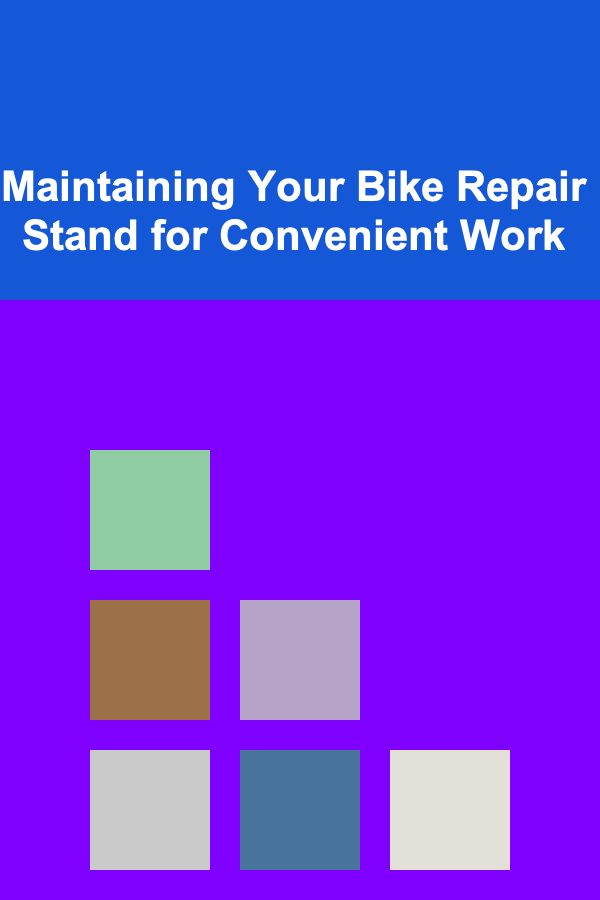
Maintaining Your Bike Repair Stand for Convenient Work
ebook include PDF & Audio bundle (Micro Guide)
$12.99$7.99
Limited Time Offer! Order within the next:

Introduction: The Unsung Hero of Bike Maintenance
A bike repair stand is more than just a piece of equipment; it's a cornerstone of any effective bike maintenance setup. It elevates your bicycle, providing a stable and accessible platform for performing everything from simple tune-ups to complex repairs. A well-maintained stand not only enhances your comfort and efficiency but also contributes to the longevity of your bicycle by allowing for precise and controlled work. Neglecting its care, however, can lead to frustrating inconveniences, compromised repairs, and ultimately, a shortened lifespan for the stand itself.
This comprehensive guide delves into the essential aspects of bike repair stand maintenance, covering everything from initial setup and regular cleaning to lubrication, troubleshooting common issues, and understanding the subtle nuances that distinguish different stand types. By following these guidelines, you'll ensure your bike repair stand remains a reliable and indispensable tool for years to come.
Understanding Your Bike Repair Stand: A Foundation for Proper Care
Before diving into maintenance procedures, it's crucial to understand the specific type of bike repair stand you own. Different designs require different approaches. Common types include:
- Clamp Stands: These stands use a clamp to grip the bike frame, typically the seat post or top tube. Clamp force is adjustable, allowing for secure holding without damaging the frame. They are the most common type.
- Bottom Bracket/Fork Mount Stands: These stands support the bike by the bottom bracket and/or fork. They offer excellent stability and are ideal for frames with unusual shapes or delicate carbon fiber structures that might be damaged by clamping. One wheel is typically removed for this setup.
- Wheel-On Stands: These stands utilize the wheels to support the bike, often with the rear wheel secured to a roller system allowing for gear adjustments while the bike is stationary. They are less common for general repair but useful for specific tasks.
- Tripod Stands: Usually Clamp Stands are on tripods for stability. The legs of the tripod may be adjustable to different heights or for uneven surfaces.
Example of a common clamp-style bike repair stand.
Familiarize yourself with the stand's components, including the clamp mechanism (if applicable), height adjustment system, leg locking mechanisms, and any other unique features. Consult the manufacturer's manual for detailed instructions and recommendations specific to your model. This manual is your primary resource for understanding the stand's intended use, weight capacity, and recommended maintenance procedures.
Initial Setup and Inspection: Setting the Stage for Long-Term Performance
The initial setup of your bike repair stand is critical for ensuring proper functionality and preventing future issues.
- Assembly: Follow the manufacturer's instructions meticulously when assembling the stand. Ensure all bolts and fasteners are properly tightened to the specified torque values (if available). Using a torque wrench is highly recommended, especially for critical components.
- Leveling: Place the stand on a level surface. If the floor is uneven, adjust the leg extensions (if equipped) to achieve a stable and wobble-free base. Using a level is helpful in this process. A stable base is paramount for safety and efficient work.
- Clamp Adjustment (for Clamp Stands): Practice adjusting the clamp tension to find the sweet spot -- tight enough to hold the bike securely but not so tight as to damage the frame. Experiment with different frame tube diameters to understand the clamp's range of adjustment.
- Height Adjustment: Familiarize yourself with the height adjustment mechanism and ensure it operates smoothly and locks securely. Experiment with different heights to find the most comfortable working position for various tasks.
- Initial Inspection: Carefully inspect all components for any signs of damage or defects. Check for loose bolts, cracks, or bent parts. Address any issues immediately to prevent further damage or potential hazards. Especially check welds if they are present.
Tip: Keep the manufacturer's manual in a safe and accessible location. You may need it for future reference or troubleshooting. Consider storing it in a plastic sleeve to protect it from moisture and dirt.
Regular Cleaning: Removing Grime and Protecting Components
Regular cleaning is essential for maintaining the smooth operation and extending the lifespan of your bike repair stand. Dirt, grease, and grime can accumulate on moving parts, hindering their functionality and accelerating wear.
- Frequency: Clean the stand after each use, especially if you've been working on a particularly dirty or greasy bike. A more thorough cleaning should be performed at least once a month, or more frequently if the stand is used heavily.
- Cleaning Supplies: Gather the necessary cleaning supplies, including:
- Mild soap or detergent
- Warm water
- Clean rags or microfiber cloths
- A brush (for scrubbing stubborn grime)
- A degreaser (for removing grease and oil)
- Cleaning Procedure:
- Wipe down all surfaces with a damp cloth to remove loose dirt and debris.
- Apply a mild soap or detergent solution to the stand, focusing on areas prone to grease and grime buildup, such as the clamp, height adjustment mechanism, and leg locking mechanisms.
- Use a brush to scrub away stubborn grime.
- Rinse the stand thoroughly with clean water.
- Dry the stand completely with clean rags.
- For grease and oil stains, apply a degreaser and follow the manufacturer's instructions.
- Clamp Cleaning (for Clamp Stands): Pay special attention to the clamp jaws. Remove any embedded dirt or debris that could scratch or damage bike frames. Use a small brush or pick to clean hard-to-reach areas.
Warning: Avoid using harsh chemicals or abrasive cleaners, as they can damage the stand's finish or corrode metal components. Always test any cleaning product on an inconspicuous area first to ensure it doesn't cause discoloration or damage. Do not use pressure washers.
Lubrication: Ensuring Smooth Operation and Preventing Wear
Proper lubrication is crucial for maintaining the smooth operation of moving parts and preventing premature wear. Regularly lubricating the height adjustment mechanism, leg locking mechanisms, and clamp mechanism (if applicable) will ensure they function effortlessly and reliably.
- Lubricants: Choose lubricants that are appropriate for the specific components of your bike repair stand. Consider the following:
- Light Oil: Suitable for general lubrication of moving parts, such as the height adjustment mechanism and leg locking mechanisms. Choose a high-quality oil designed for bicycle components.
- Grease: Ideal for lubricating threaded components, such as bolts and fasteners. Grease provides long-lasting lubrication and prevents corrosion.
- Dry Lube: A good option for the clamp mechanism (for clamp stands), as it provides lubrication without attracting excessive dirt and grime. Apply sparingly.
- Lubrication Procedure:
- Clean the components to be lubricated, removing any existing dirt or grime.
- Apply a small amount of lubricant to the moving parts.
- Work the lubricant into the components by moving them back and forth.
- Wipe away any excess lubricant.
- Specific Component Lubrication:
- Height Adjustment Mechanism: Apply light oil to the sliding surfaces of the height adjustment mechanism. Work the mechanism up and down to distribute the lubricant.
- Leg Locking Mechanisms: Apply light oil to the locking pins or levers of the leg locking mechanisms. Ensure the mechanisms lock and unlock smoothly.
- Clamp Mechanism (for Clamp Stands): Apply dry lube to the clamp jaws and adjustment knob. Avoid applying excessive lubricant, as it can attract dirt.
- Threads: When disassembling and reassembling any parts with threads, use grease on the threads to prevent seizing and corrosion.
Tip: Use a syringe or needle applicator to apply lubricant precisely to hard-to-reach areas. This will minimize waste and prevent lubricant from getting on unintended surfaces.
Troubleshooting Common Issues: Identifying and Resolving Problems
Even with regular maintenance, bike repair stands can occasionally experience problems. Here are some common issues and their potential solutions:
- Stand Wobbles:
- Cause: Uneven floor, loose leg locking mechanisms, or damaged leg extensions.
- Solution: Adjust the leg extensions to level the stand on an uneven floor. Tighten the leg locking mechanisms. Inspect the leg extensions for damage and replace if necessary.
- Clamp Doesn't Hold Securely (for Clamp Stands):
- Cause: Worn clamp jaws, insufficient clamp tension, or grease on the frame tube.
- Solution: Clean the clamp jaws and the frame tube with a degreaser. Adjust the clamp tension to a higher setting. Replace the clamp jaws if they are worn or damaged. Consider using a small piece of rubber to increase friction between the clamp and the frame.
- Height Adjustment Mechanism Sticks:
- Cause: Dirt and grime buildup, lack of lubrication, or damaged components.
- Solution: Clean the height adjustment mechanism thoroughly. Apply light oil to the sliding surfaces. Inspect the mechanism for damage and replace any worn or broken parts.
- Leg Locking Mechanisms Don't Engage:
- Cause: Dirt and grime buildup, lack of lubrication, or damaged locking pins or levers.
- Solution: Clean the leg locking mechanisms thoroughly. Apply light oil to the locking pins or levers. Inspect the mechanisms for damage and replace any worn or broken parts.
- Rust:
- Cause: Exposure to moisture.
- Solution: Remove rust with a wire brush or steel wool. Apply a rust inhibitor and then paint to prevent future rust. Store the stand in a dry place.
Warning: If you are unable to resolve a problem on your own, consult a qualified bike mechanic or contact the manufacturer for assistance. Attempting to repair the stand without proper knowledge or tools could result in further damage or injury.
Storage: Protecting Your Investment When Not in Use
Proper storage is essential for protecting your bike repair stand from the elements and preventing damage when it's not in use.
- Clean Before Storing: Before storing the stand, clean it thoroughly to remove any dirt, grease, or grime.
- Dry Completely: Ensure the stand is completely dry before storing it to prevent rust and corrosion.
- Indoor Storage: The ideal storage location is indoors, in a dry and protected environment. Avoid storing the stand in damp or humid areas, such as basements or garages.
- Covering: If you must store the stand outdoors, cover it with a waterproof tarp or cover to protect it from the elements.
- Folding (if applicable): If your stand is foldable, fold it down to its most compact configuration for storage.
- Secure Storage: Store the stand in a secure location where it won't be knocked over or damaged. Consider storing it in a closet or hanging it on a wall.
Preventative Maintenance: Proactive Steps for Long-Term Reliability
In addition to regular cleaning and lubrication, there are several preventative maintenance steps you can take to extend the life of your bike repair stand and ensure its continued reliability.
- Regular Inspections: Periodically inspect the stand for any signs of damage or wear. Check for loose bolts, cracks, bent parts, or corrosion. Address any issues promptly to prevent them from escalating.
- Tighten Loose Bolts: Regularly check and tighten all bolts and fasteners to the specified torque values (if available). Loose bolts can compromise the stand's stability and functionality.
- Replace Worn Parts: Replace any worn or damaged parts as soon as possible. Worn parts can affect the stand's performance and potentially lead to more serious problems. Contact the manufacturer or a reputable bike shop for replacement parts.
- Protect from the Elements: Avoid exposing the stand to excessive moisture, sunlight, or extreme temperatures. These conditions can accelerate wear and corrosion.
- Use Within Weight Capacity: Always use the stand within its specified weight capacity. Overloading the stand can damage its components and compromise its stability.
- Proper Usage: Use the stand for its intended purpose. Avoid using it as a ladder or for lifting excessively heavy objects.
Advanced Maintenance (Optional): Deeper Dive for the Dedicated User
For users who are particularly dedicated to maintaining their bike repair stands, there are some advanced maintenance procedures that can further enhance its performance and longevity. These procedures typically require more specialized tools and knowledge.
- Disassembly and Overhaul: Periodically disassemble the stand completely for a thorough cleaning and inspection. Clean all components meticulously and replace any worn or damaged parts. Reassemble the stand with fresh grease and lubricants.
- Welding Repairs (if applicable): If the stand has any cracks or breaks in the welds, consider having them professionally repaired by a certified welder. Welding repairs can restore the stand's structural integrity. However, DIY welding is generally not recommended unless you have the necessary skills and equipment.
- Powder Coating or Painting: If the stand's finish is damaged or corroded, consider having it powder coated or painted. Powder coating provides a durable and corrosion-resistant finish. Painting can also improve the stand's appearance and protect it from the elements.
- Bearing Replacement (if applicable): Some more complex stands may utilize bearings in rotating parts. If these bearings become rough or noisy, replacing them can restore smooth operation. This requires identifying the correct bearing size and type, and having the appropriate tools for removal and installation.
Warning: Advanced maintenance procedures should only be performed by experienced individuals with the necessary skills and tools. Improperly performed maintenance could result in further damage or injury.
Conclusion: A Well-Maintained Stand: A Partner in Cycling Success
A bike repair stand, when properly maintained, becomes an invaluable partner in your cycling journey. By investing time and effort in its care, you ensure smooth, efficient, and safe bike maintenance, prolonging the life of your bicycle and enhancing your overall riding experience. This comprehensive guide provides the knowledge and techniques necessary to keep your stand in top condition, from basic cleaning and lubrication to advanced troubleshooting and preventative measures. Embrace these practices, and you'll enjoy years of reliable service from your bike repair stand, enabling you to tackle any repair or maintenance task with confidence and ease. Remember to always consult your owner's manual for model specific advice.
Reading More From Our Other Websites
- [Home Pet Care 101] How to Create a Safe and Comfortable Space for Your Pets at Home
- [Personal Investment 101] How to Make Money with Deep Learning: 5 Profitable Ideas
- [Personal Finance Management 101] How to Plan for Retirement While Managing Current Expenses
- [Mindful Eating Tip 101] Best Mindful Eating Practices for People Living in Food Deserts
- [Home Family Activity 101] How to Have a Family Karaoke Night at Home
- [Home Rental Property 101] How to Maintain Your Rental Property on a Budget
- [Home Budget 101] How to Budget for Home Cleaning and Keep Your Home Sparkling
- [Home Family Activity 101] How to Foster Open Communication During Family Activities
- [Home Budget Decorating 101] How to Choose Budget-Friendly Window Treatments That Still Look Elegant
- [Personal Investment 101] How to Authenticate and Value Pieces When Investing in Art and Collectibles

How to Build a Financial Plan for a Small Business Owner
Read More
How to Maintain Your Pet's Physical and Mental Health Together
Read More
Turning Deep Learning into a Profitable Business Venture
Read More
How to Master Robot Motion Control
Read More
How to Get Started with White Water Rafting
Read More
How to Personalize a Funeral with Unique Cultural Traditions
Read MoreOther Products

How to Build a Financial Plan for a Small Business Owner
Read More
How to Maintain Your Pet's Physical and Mental Health Together
Read More
Turning Deep Learning into a Profitable Business Venture
Read More
How to Master Robot Motion Control
Read More
How to Get Started with White Water Rafting
Read More